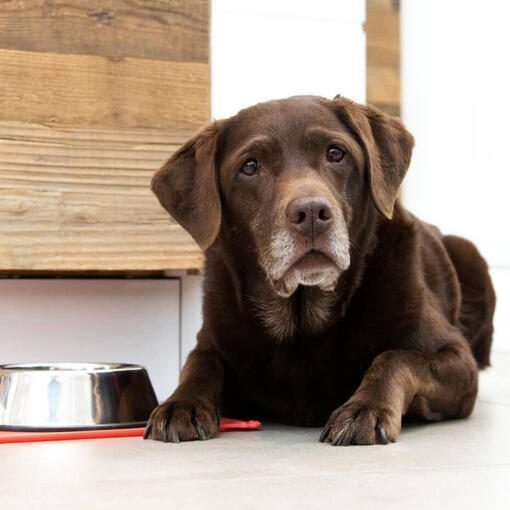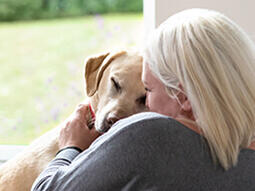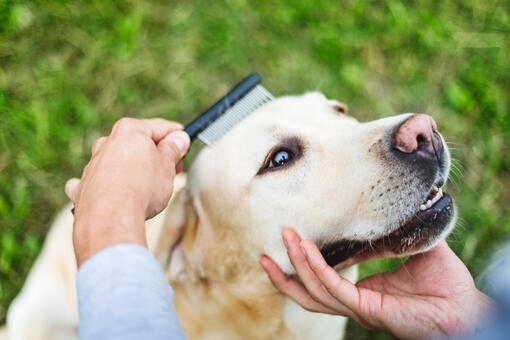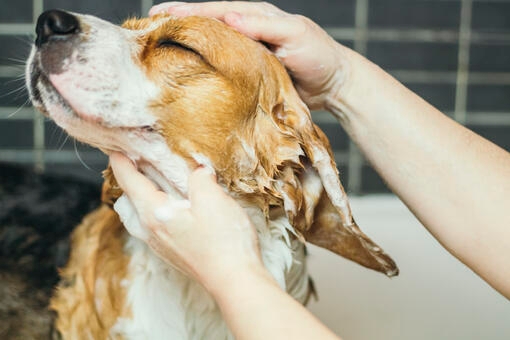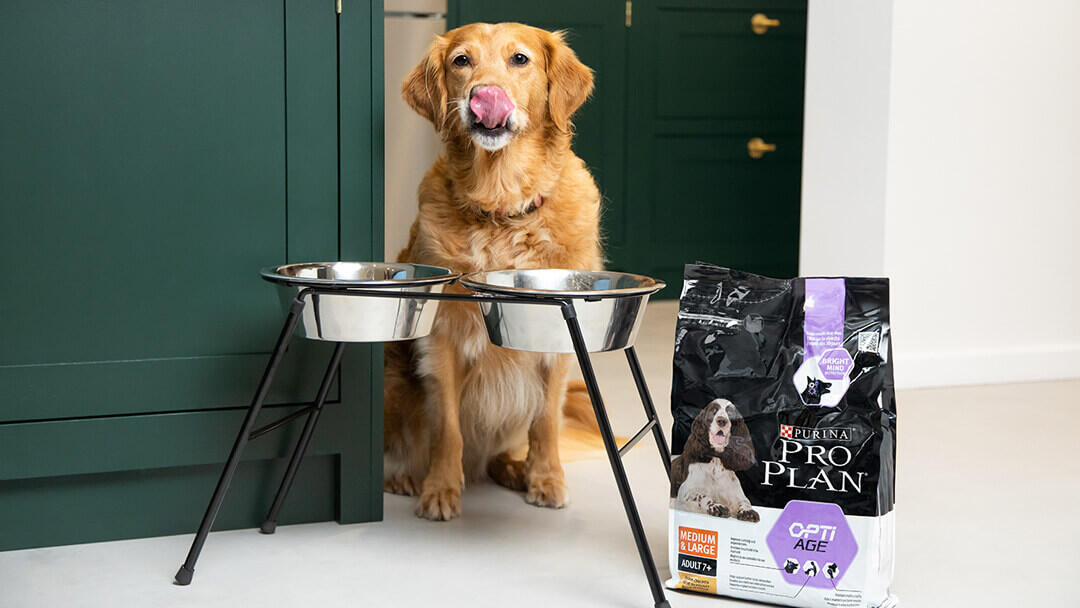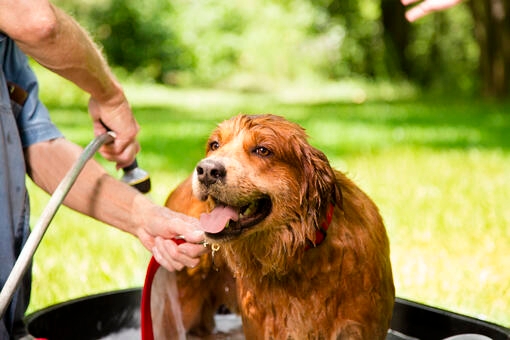
As our furry friends age, their needs shift, and we need to adapt how we care for them. Grooming isn't just about making our dogs look good; it's a vital part of keeping them healthy and clean, especially as they reach their twilight years.
Grooming gives you a chance to monitor any new lumps or bumps and is a great way to spend quality time with your dog at a time in their life when you are maybe exercising them less.
But don't worry; by making a few changes, using the right approach and eating the right senior dog food, we can ensure our ageing pets stay healthy, happy and well-groomed.
Grooming Routines for Senior Dogs
Adjusting Frequency and Methods:
The skin and coat of senior dogs can get more sensitive and dry out easily, so it's really important to adjust how often we groom them. It's not just about the number of times we groom them, but also how we do it. We need to make sure we're as gentle as possible to prevent any stress or discomfort while still being thorough. A tender touch and plenty of patience can make a world of difference.
Tools and Products Suitable for Sensitive Skin:
When picking out grooming tools, go for softer brushes and combs made for sensitive skin that will still be effective but avoid any potential discomfort.
Grooming Your Dog with Joint Pain and Mobility Issues
Techniques to Minimise Discomfort:
As dogs age, long grooming sessions can become challenging or even painful – as holding certain positions while you give them a thorough grooming isn’t as easy as it used to be. Instead of doing a long thorough groom every week, do short sessions each day, focusing on a different part of the body.
If you bring your dog home from a walk wet or muddy, clean them up straight away and make sure they are thoroughly dried.
This is especially important for senior dogs dealing with arthritis or joint pain, and it will ensure that your dog doesn’t get matted, tangled or dirty, leading to long and potentially uncomfortable grooming sessions.
Keeping on top of coat care with short more frequent grooming sessions will keep your dog’s coat in tip top condition, while not putting strain on ageing or painful joints and muscles.
Positioning and Support During Grooming:
It's important to find the best grooming positions that put the least amount of strain on your dog's body. While your dog may have been happy to stand for hours while you groomed them in their younger days, being able to lie down for at least some of the time can make things far easier for them now they are older, stiffer and possibly achier Often doing some of the grooming their own bed can be ideal for them – plus you can move them around without joints or bones being knocked or hurt on hard surfaces.
Using pillows or supportive harnesses (if you use a grooming table) can provide extra comfort and support, making grooming a pain-free experience for your veteran dog.
Senior Dog Bathing Tips
Choosing the Right Shampoo for Senior Dogs:
Choosing the right shampoo is super important for our older dogs. Keep an eye out for products that will still suit your dog’s coat type but that are specially made for senior dogs and that have a neutral pH balance to avoid any skin irritation. Avoid products that contain ingredients like harsh chemicals and strong fragrances. Hypoallergenic shampoos and conditioners are far better choice since they are less likely to irritate sensitive skin.
Safe Bathing Practices for Dogs with Limited Mobility:
Bath time can be a challenge for those with limited mobility. Taking it step by step and using non-slip mats both in the shower and in the bathroom itself, are important to prevent your dog from slipping or having to brace themselves to prevent sliding – which can put strain on ageing joints and muscles or even cause injury. A walk-in shower/bath with a handheld attachment is ideal but if you need to get use a high-sided bath, ramps can be invaluable for you both.
Water should be warm but not hot as your senior dog’s skin is likely to be more sensitive to heat, and hot water can dry out skin and exacerbate any hot spots.
Brushing and Coat Maintenance
Gentle Brushing Techniques:
Brushing an older dog is a delicate balance of being gentle and using the softest possible tools, while still getting right through their coats to detangle and keep both hair and skin healthy. A lot will depend on your dog’s coat type how you can best do that. Little and often is the best mantra here.
Look on grooming your older dog as a social bonding experience:
Older dogs need your love and attention as much as they ever did. They are at a time in their lives where you might be giving them less exercise and training, and so interacting with them less. Grooming and even a spot of canine massage gives you a way to spend quality time with your senior dog.
Dealing with Matting and Shedding:
All coated dogs get matts and tangles but the secret to keeping your dog’s coat healthy and comfortable, is to remove these tangles as soon as they start to form. This is especially important in older dogs who will find it uncomfortable to stand for long periods while you detangle them and fight with old matts. The right tools, like de-matting combs or brushes, along with grooming sprays, can make dealing with tangles far easier but nothing beats keeping on top of these. Regular maintenance is better than dealing with a tangled mess later on.
Senior Dog Nail Care
Signs of Overgrown Nails and Their Impact on Mobility:
If your senior dog is exercising less or isn’t walking on roads or pavements as much as they used to, their nails can become overgrown. Overgrown nails are not just an aesthetic issue; they can lead to pain, joint problems, mobility issues and discomfort. Spotting the signs early on can help avoid bigger problems in the future, and checking your senior dog’s nails should be part of every grooming session.
Tips for Trimming Nails Without Causing Pain:
Trimming nails should never be a painful ordeal. Safe methods and tools, like nail grinders, can help avoid pain or discomfort. If you are not confident trimming your dog’s nails yourself, visit your veterinary practice or local groomer who will be able to help quickly and easily and may be able to show you how to do it yourself in the future.
When looking after your dog's claws, ensure you have a calm environment and take your time. It’s important that you do this without any stress to your dog and if you are using nail clippers, without catching the sensitive quick that runs part of the way down the claw that will cause pain and bleeding.
Using Treats During Grooming
Incorporating Dog Treats to Ease Stress:
Incorporating dog treats can make grooming sessions more enjoyable. Just make sure to pick treats that are good for older dogs and consider their dietary needs.
Positive Reinforcement Strategies:
As your dog ages, the time you spend together becomes even more precious, and grooming, while it has always been a part of your dog’s life, is the perfect way to maintain your relationship, spend quality time together, and interact in a positive, mutually fulfilling way. Coupling this with delicious treats, makes this time even more positive and reinforcing for your dog – and for you too.

